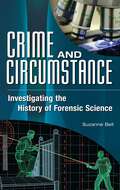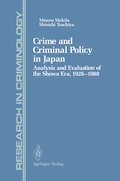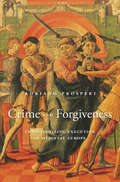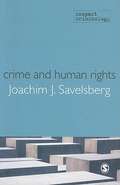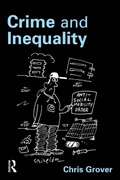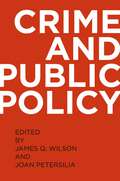- Table View
- List View
Crime: Bodysnatchers, Computer Crime And The Mafia - Does Crime Ever Pay? (Trailblazers Ser.)
by David OrmeWhat links pirates, body snatchers, gangsters and people smugglers? The answer is that they are all criminals. Find out about crime through the ages - and how the Internet is now being used for new kinds of crime. Then find out about the silliest punishment ever! Get the facts. Then read a true story about body snatchers who couldn't wait for people to die: 'Burke and Hare'. This fantastic book features an exciting combination of both fiction and non-fiction. The non-fiction section enables readers to engage with the subject matter, using dramatic illustrations and bite-sized texts. The beautifully illustrated fiction story appears in two formats - short, simple texts for more able readers and an illustrated 'speech bubble' version of the same story, for those who are really struggling. Part of the Trailblazers series, this book is brilliant for keeping reluctant readers engaged.
Crime and Art: Sociological and Criminological Perspectives of Crimes in the Art World (Studies in Art, Heritage, Law and the Market #1)
by Naomi Oosterman Donna YatesThis volume brings together work by authors who draw upon sociological and criminological methods, theory, and frameworks, to produce research that pushes boundaries, considers new questions, and reshape the existing understanding of "art crimes", with a strong emphasis on methodological innovation and novel theory application. Criminologists and sociologists are poorly represented in academic discourse on art and culture related crimes. However, to understand topics like theft, security, trafficking, forgery, vandalism, offender motivation, the efficacy of and results of policy interventions, and the effects art crimes have on communities, we must develop the theoretical and methodological models we use for analyses. The readership of this book is expected to include academics, researchers, and practitioners in the fields of criminology, sociology, law, and heritage studies who have an interest in art and heritage crime.
Crime and Circumstance: Investigating the History of Forensic Science (Non-ser.)
by Suzanne BellToday, there is more interest in forensic science than ever before. Crime and Circumstance weaves an intriguing tale of how an obscure corner of medicine dating back to ancient times matured into modern forensic science. The author explores the scientific and social threads that created forensic science and continue to drive its evolution in an entertaining narrative that introduces readers to intriguing cases and personalities across history, countries, and cultures and helps readers translate what they encounter in popular media into the reality of forensic science and laboratory investigation.Through historical and contemporary examples, Bell illustrates how cutting-edge research migrates to forensic laboratories, a transfer that is more indirect than people might expect. Although science and the judicial system both pursue truth, the interface between them is anything but seamless. This unique historical approach focuses on personalities from scientific law enforcement and emphasizes the myriad discoveries made over the years. Through these stories, the reader is introduced to the underlying science in an interesting, lively, and accessible way.
Crime and Corruption in Organizations: Why It Occurs and What To Do About It (Psychological and Behavioural Aspects of Risk)
by Ronald J. Burke Edward C. TomlinsonAlthough increasing attention has been paid to it, there are no signs that crime and corruption in organizations is decreasing, so if you're a manager or government policy maker, and your mandate is to reduce crime and corruption, where do you start? The international authors of this book fill a critical need to address such a prevalent and costly topic with a detailed analysis of the risks associated with crime and corruption in organizations. They examine the causes and consequences, and the choices we face in our efforts to eradicate these social maladies. They focus on the risks to individuals and organizations surrounding criminal and corrupt acts, with an emphasis on the psychological, behavioral and organizational factors supporting such behaviors. Finally, they explore the phenomenon of crime and corruption across a diverse array of organizational settings (ranging from public to private, for-profit to non-profit) and occupational categories (e.g., police officers, physicians, accountants, and academicians). The constant barrage of scandals publicized by the media demands 'front burner' attention dedicated to stemming this tide. Accordingly, this book turns to prominent researchers employing their talents to produce more ethical organizations. The result is the most up-to-date thinking on both classic (e.g., cognitive moral development) and novel (e.g., moral attentiveness) approaches to crime and corruption, as well as scientifically-grounded approaches to reducing illicit behavior in organizations.
Crime and Corruption in Organizations: Why It Occurs and What To Do About It (Psychological and Behavioural Aspects of Risk)
by Ronald J. Burke Edward C. TomlinsonAlthough increasing attention has been paid to it, there are no signs that crime and corruption in organizations is decreasing, so if you're a manager or government policy maker, and your mandate is to reduce crime and corruption, where do you start? The international authors of this book fill a critical need to address such a prevalent and costly topic with a detailed analysis of the risks associated with crime and corruption in organizations. They examine the causes and consequences, and the choices we face in our efforts to eradicate these social maladies. They focus on the risks to individuals and organizations surrounding criminal and corrupt acts, with an emphasis on the psychological, behavioral and organizational factors supporting such behaviors. Finally, they explore the phenomenon of crime and corruption across a diverse array of organizational settings (ranging from public to private, for-profit to non-profit) and occupational categories (e.g., police officers, physicians, accountants, and academicians). The constant barrage of scandals publicized by the media demands 'front burner' attention dedicated to stemming this tide. Accordingly, this book turns to prominent researchers employing their talents to produce more ethical organizations. The result is the most up-to-date thinking on both classic (e.g., cognitive moral development) and novel (e.g., moral attentiveness) approaches to crime and corruption, as well as scientifically-grounded approaches to reducing illicit behavior in organizations.
Crime and Crime Control: A Global View (A World View of Social Issues)
by Gregg BarakAre crime rates rising or falling around the world? Are specific types of crime more prevalent in some cultures than others? Do different cultures vary greatly in their attitudes toward crime prevention? Students will find answers to these and similar questions in this unique resource of 15 case studies exploring the problems of crime and crime control in different countries, ranging from Germany to Ghana, to around the world. Cross-cultural comparisons examine the history, the public perceptions, contemporary problems, and the future of crime and crime control in each country. The comparisons also provide readers with the opportunity to discover both the many differences and the many similarities that exist among the different cultures in their rates of crime, forms of prevention, and attitudes toward it.Each of the 15 chapters opens with a brief overview, which includes the type of government and the living environment of the country to introduce readers to the population. The countries were chosen to represent every region of the world and to provide as broad a picture as possible when exploring the issues presented by the problem of crime and different cultures' efforts to control it. The user-friendly format of the volume, with each chapter following the same outline, makes it easy for readers to compare specific aspects among the 15 cultures. These different views of the crime problem around the world and what it means to different people will help students to understand it in a broad sense as a social issue that affects all of humanity.
Crime and Criminal Justice in Modern Germany (Studies in German History #16)
by Richard F. WetzellThe history of criminal justice in modern Germany has become a vibrant field of research, as demonstrated in this volume. Following an introductory survey, the twelve chapters examine major topics in the history of crime and criminal justice from Imperial Germany, through the Weimar and Nazi eras, to the early postwar years. These topics include case studies of criminal trials, the development of juvenile justice, and the efforts to reform the penal code, criminal procedure, and the prison system. The collection also reveals that the history of criminal justice has much to contribute to other areas of historical inquiry: it explores the changing relationship of criminal justice to psychiatry and social welfare, analyzes representations of crime and criminal justice in the media and literature, and uses the lens of criminal justice to illuminate German social history, gender history, and the history of sexuality.
Crime and Criminal Justice in Modern Germany (Studies in German History #16)
by Richard F. WetzellThe history of criminal justice in modern Germany has become a vibrant field of research, as demonstrated in this volume. Following an introductory survey, the twelve chapters examine major topics in the history of crime and criminal justice from Imperial Germany, through the Weimar and Nazi eras, to the early postwar years. These topics include case studies of criminal trials, the development of juvenile justice, and the efforts to reform the penal code, criminal procedure, and the prison system. The collection also reveals that the history of criminal justice has much to contribute to other areas of historical inquiry: it explores the changing relationship of criminal justice to psychiatry and social welfare, analyzes representations of crime and criminal justice in the media and literature, and uses the lens of criminal justice to illuminate German social history, gender history, and the history of sexuality.
Crime and Criminal Justice (PDF)
by Ian Marsh Gaynor Melville John Cochrane Keith Morgan Gareth NorrisCrime and Criminal Justice provides students with a comprehensive and engaging introduction to the study of criminology by taking an interdisciplinary approach to explaining criminal behaviour and criminal justice. The book is divided into two parts, which address the two essential bases that form the discipline of criminology. Part One describes, discusses and evaluates a range of theoretical approaches that have offered explanations for crime, drawing upon contributions from the disciplines of sociology, psychology, and biology. It then goes on to apply these theories to specific forms of criminality. Part Two offers an accessible but detailed review of the major philosophical aims and sociological theories of punishment, and examines the main areas of the contemporary criminal justice system #65533; including the police, the courts and judiciary, prisons, and more recent approaches to punishment. Presenting a clear and thorough review of theoretical thinking on crime, and of the context and current workings of the criminal justice system, this book provides students with an excellent grounding in the study of criminology.
Crime And Criminal Justice Policy (PDF)
by Tim Newburn'Crime and Criminal Justice Policy', second edition, provides a general update and revision, and records the substantial changes in British criminal justice policy and legislation over the last five years, particularly those introduced by the Crime and Disorder Act 1998. There is also a new chapter on crime prevention and community safety and more.
Crime and Criminal Policy in Japan: Analysis and Evaluation of the Showa Era, 1926–1988 (Research in Criminology)
by Minoru Shikita Shinichi TsuchiyaThe Showa Era in Japan commenced in December 1926, when Emperor Showa ascended the Throne, and came to an end in January 1989, when His Majesty passed away, ushering in the new Heisei Era. The Showa Era was marked by drastic changes in the economy, society, and political and legal sys tems, which brought about an ebb and flow in criminality and precipitated various criminal policies. From an economical, political, and criminological perspective, the Showa Era stands out as a remarkable period in Japanese his tory. The Research and Training Institute of the Ministry of Justice, which has annually published the White Paper on Crime in Japan since 1960, received Cabinet approval to introduce a special topic section, "Criminal Policy in Sho wa" in the White Paper for 1989, which was published in October the same year. This White Paper is the first comprehensive publication that deals not only with the crime situation but also with the various activities of the criminal justice system, including the police, public prosecutors' offices, courts, correctional institutions, and probation and parole supervision organisations for 63 years.
Crime and Culture: An Historical Perspective (New Advances in Crime and Social Harm)
by AMY GILMAN SREBNICK AND RENÉ LÉVYScholarly interest in the history of crime has grown dramatically in recent years and, because scholars associated with this work have relied on a broad social definition of crime which includes acts that are against the law as well as acts of social banditry and political rebellion, crime history has become a major aspect not only of social history, but also of cultural as well as legal studies. This collection explores how the history of crime provides a way to study time, place and culture. Adopting an international and interdisciplinary perspective to investigate the historical discourses of crime in Europe and the United States from the sixteenth to the late twentieth century, these original works provide new approaches to understanding the meaning of crime in modern western culture and underscore the new importance given to crime and criminal events in historical studies. Written by both well-known historians and younger scholars from across the globe, the essays reveal that there are important continuities in the history of crime and its representations in modern culture, despite particularities of time and place.
Crime and Culture: An Historical Perspective (New Advances in Crime and Social Harm)
by René Lévy Amy Gilman SrebnickScholarly interest in the history of crime has grown dramatically in recent years and, because scholars associated with this work have relied on a broad social definition of crime which includes acts that are against the law as well as acts of social banditry and political rebellion, crime history has become a major aspect not only of social history, but also of cultural as well as legal studies. This collection explores how the history of crime provides a way to study time, place and culture. Adopting an international and interdisciplinary perspective to investigate the historical discourses of crime in Europe and the United States from the sixteenth to the late twentieth century, these original works provide new approaches to understanding the meaning of crime in modern western culture and underscore the new importance given to crime and criminal events in historical studies. Written by both well-known historians and younger scholars from across the globe, the essays reveal that there are important continuities in the history of crime and its representations in modern culture, despite particularities of time and place.
Crime and Deviance in Cyberspace (International Library Of Criminology, Criminal Justice And Penology - Second Ser. #Vol. 2)
by David S. WallThis volume presents the reader with an interesting and, at times, provocative selection of contemporary thinking about cybercrimes and their regulation. The contributions cover the years 2002-2007, during which period internet service delivery speeds increased a thousand-fold from 56kb to 56mb per second. When combined with advances in networked technology, these faster internet speeds not only made new digital environments more easily accessible, but they also helped give birth to a completely new generation of purely internet-related cybercrimes ranging from spamming, phishing and other automated frauds to automated crimes against the integrity of the systems and their content. In order to understand these developments, the volume introduces new cybercrime viewpoints and issues, but also a critical edge supported by some of the new research that is beginning to challenge and surpass the hitherto journalistically-driven news stories that were once the sole source of information about cybercrimes.
Crime and Deviance in Cyberspace
by DavidS. WallThis volume presents the reader with an interesting and, at times, provocative selection of contemporary thinking about cybercrimes and their regulation. The contributions cover the years 2002-2007, during which period internet service delivery speeds increased a thousand-fold from 56kb to 56mb per second. When combined with advances in networked technology, these faster internet speeds not only made new digital environments more easily accessible, but they also helped give birth to a completely new generation of purely internet-related cybercrimes ranging from spamming, phishing and other automated frauds to automated crimes against the integrity of the systems and their content. In order to understand these developments, the volume introduces new cybercrime viewpoints and issues, but also a critical edge supported by some of the new research that is beginning to challenge and surpass the hitherto journalistically-driven news stories that were once the sole source of information about cybercrimes.
Crime and Empire 1840–1940: Criminal justice in local and global context
by Barry S. Godfrey Graeme DunstallThis book is a major contribution to the comparative histories of crime and criminal justice, focusing on the legal regimes of the British empire during the nineteenth and early twentieth centuries. Its overarching theme is the transformation and convergence of criminal justice systems during a period that saw a broad shift from legal pluralism to the hegemony of state law in the European world and beyond.
Crime and Forgiveness: Christianizing Execution in Medieval Europe
by Adriano ProsperiA provocative analysis of how Christianity helped legitimize the death penalty in early modern Europe, then throughout the Christian world, by turning execution into a great cathartic public ritual and the condemned into a Christ-like figure who accepts death to save humanity. The public execution of criminals has been a common practice ever since ancient times. In this wide-ranging investigation of the death penalty in Europe from the fourteenth to the eighteenth century, noted Italian historian Adriano Prosperi identifies a crucial period when legal concepts of vengeance and justice merged with Christian beliefs in repentance and forgiveness. Crime and Forgiveness begins with late antiquity but comes into sharp focus in fourteenth-century Italy, with the work of the Confraternities of Mercy, which offered Christian comfort to the condemned and were for centuries responsible for burying the dead. Under the brotherhoods’ influence, the ritual of public execution became Christianized, and the doomed person became a symbol of the fallen human condition. Because the time of death was known, this “ideal” sinner could be comforted and prepared for the next life through confession and repentance. In return, the community bearing witness to the execution offered forgiveness and a Christian burial. No longer facing eternal condemnation, the criminal in turn publicly forgave the executioner, and the death provided a moral lesson to the community. Over time, as the practice of Christian comfort spread across Europe, it offered political authorities an opportunity to legitimize the death penalty and encode into law the right to kill and exact vengeance. But the contradictions created by Christianity’s central role in executions did not dissipate, and squaring the emotions and values surrounding state-sanctioned executions was not simple, then or now.
Crime and Global Justice: The Dynamics of International Punishment
by Daniele Archibugi Alice PeaseOver the last quarter of a century a new system of global criminal justice has emerged. But how successful has it been? Are we witnessing a new era of cosmopolitan justice or are the old principles of victors’ justice still in play? In this book, Daniele Archibugi and Alice Pease offer a vibrant and thoughtful analysis of the successes and shortcomings of the global justice system from 1945 to the present day. Part I traces the evolution of this system and the cosmopolitan vision enshrined within it. Part II looks at how it has worked in practice, focusing on the trials of some of the world’s most notorious war criminals, including Augusto Pinochet, Slobodan Milošević, Radovan Karad ić, Saddam Hussein and Omar al-Bashir, to assess the efficacy of the new dynamics of international punishment and the extent to which they can operate independently, without the interference of powerful governments and their representatives. Looking to the future, Part III asks how the system’s failings can be addressed. What actions are required for cosmopolitan values to become increasingly embedded in the global justice system in years to come?
Crime and Human Rights: Criminology Of Genocide And Atrocities (PDF)
by Joachim Savelsberg'Joachim Savelsberg brings a unique perspective and research background to the topic of crime and human rights.The book provides a succinct and penetrating analysis that persuasively explains why contemporary criminology must widen its boundaries to make human rights crimes a priority for our field.nbsp;This book is essential reading for scholars and students.' - John Hagan, MacArthur Professor, Northwestern University. 'Joachim Savelsberg is one of the world's finest sociologists of crime and the institutions through which it is constituted and controlled.nbsp;In this brief but path-breaking study he shows how the tools of criminological analysis can deepen our understanding of the processes that produce genocide and crimes against humanity - and why an engagement with human rights is essential for a 21st century criminology that aspires to depth and relevance.' - David Garland, New York University, USA. Crimes against humanity are amongst the most shocking violations imaginable. Savelsberg's text provides a much-needed criminological insight to the topic, exploring explanations of and responses to human rights abuses. Linking human rights scholarship with criminological theory, the book is divided into three parts: Part 1: Examines the legal and historical approach to the topic within a criminological framework. Part 2: Unpicks the aetiology of human rights offending with real and detailed case studies. Part 3: Explores institutional responses to crimes and uses criminological theory to offer solutions. Seminal yet concise, Crime and Human Rights is written for advanced students, postgraduates and scholars of crime, crime control and human rights. With its fresh and original approach to a complex topic, the book's appeal will span across disciplines from politics and sociology to development studies, law, and philosophy.
Crime and Inequality
by Chris GroverThis book examines key relationships between material circumstances and crime, and analyzes the areas of social policy - in particular social security and labour market policy - that are most important in terms of dealing with inequality at the lower end of the income hierarchy. It seeks to explain why inequality is linked to offending behaviour and the evidence underpinning explanations for this, and looks in detail at the relationship between offending and anti-social behaviour and its management through social policy interventions. Crime and Inequality draws upon both criminological and social policy approaches to understand this vital relationship, moving beyond criminological approaches which often fail to analyse the way the state attempts to manage poor material circumstance, offending and anti-social behaviour through social policy. The main aims of the book are threefold: to draw upon the disciplines of both criminology and social policy to understand the relationship between crime and inequality; to provide an in-depth analysis of those aspects of social policy that have a bearing on the context, management and punishment of offending behaviour; to examine government crime and anti-social behaviour policies in the context of social security and labour market policies, and to identify the tensions that have resulted from attempts to address social justice issues while also making individuals responsible for their actions. Alternate ISBN 9781843923305
Crime and Intelligence Analysis: An Integrated Real-Time Approach
by Glenn Grana James WindellCrime and Intelligence Analysis: An Integrated Real-Time Approach covers everything crime analysts and tactical analysts need to know to be successful. Providing an overview of the criminal justice system as well as the more fundamental areas of crime analysis, the book will enable students and law enforcement personnel to better understand criminal behavior, learn the basics of conducting temporal analysis of crime patterns, use spatial analysis to better understand crime, apply research methods to crime analysis, and more successfully evaluate data and information to help predict criminal offending and solve criminal cases. Criminal justice and police academy students will learn how to be skilled and credible crime analysts who play a critical role in the daily operations of law enforcement.
Crime and Intelligence Analysis: An Integrated Real-Time Approach
by Glenn Grana James WindellCrime and Intelligence Analysis: An Integrated Real-Time Approach covers everything crime analysts and tactical analysts need to know to be successful. Providing an overview of the criminal justice system as well as the more fundamental areas of crime analysis, the book will enable students and law enforcement personnel to better understand criminal behavior, learn the basics of conducting temporal analysis of crime patterns, use spatial analysis to better understand crime, apply research methods to crime analysis, and more successfully evaluate data and information to help predict criminal offending and solve criminal cases. Criminal justice and police academy students will learn how to be skilled and credible crime analysts who play a critical role in the daily operations of law enforcement.
Crime and Justice in America: Critical Issues for the Future
by John T. O'Brien Marvin MarcusCrime and Justice in America: Critical Issues of the Future is a part of the Pergamon Policy Studies and is divided in five parts reflecting five broad problem areas. This collection is from authors chosen based on their exposure to the field of criminal justice and proven expertise in a particular area. The book deals with the forecasting ability of the police for developments over the whole field of public affairs. The first part is concerned with public law enforcement on local, county, state, and national government levels of the American federal system. A particular problem is discussed on each of these levels. The second problem area concerns the most confusing segment of the justice system – the move from the public to the private sector of criminal justice. The growth of campus, school police, and other private police is suggested to assist the public sector. The third part deals with organized crime, terrorism, and hostage negotiations as being grave threats to society. To fight them requires cooperation, even consolidation, and intelligence sources. Organized crime is discussed in the fourth section, where American penal laws are seemingly a reflection of religious mores. The last section covers personnel matters in the criminal justice system and anticipated developments after achieving professionalism in the police and correctional services. This book is intended for scholars, practitioners, and students of criminal justice. This text can prove useful to practitioners in the fields of sociology, psychology, and public administration. This book is also recommended for investigators and private citizens interested in the study of criminal justice.
Crime and Morality: The Significance of Criminal Justice in Post-modern Culture
by J.C. BoutellierOver the last twenty-five years the significance of criminal justice has dramatically changed. In a "post-modern" culture, criminal law serves more and more as a focal point in public morality. The "discovery" of the victim of crime can be seen as the marking point by which criminal justice got its central position in the maintenance of social order. It is the result of a general "victimalization" of today's morality. This ingenious book - according to Michael Tonry - combines insights from criminology, sociology and moral philosophy. It is especially inspired by the work of Richard Rorty, who stresses the sensibility for suffering as the major source of morality in post-modern times. It describes the arousal of attention for victims and the development of crime prevention. More specifically, it analyzes child sexual abuse and prostitution. This "illuminating" book will be an eye-opener for theorists in criminology and moral philosophy, but will also be an inspiring work for policy makers in the area of criminal justice.
Crime and Public Policy
by James Q. Wilson & Joan PetersiliaCrime in the United States has fluctuated considerably over the past thirty years, as have the policy approaches to deal with it. During this time criminologists and other scholars have helped to shed light on the role of incarceration, prevention, drugs, guns, policing, and numerous other aspects to crime control. Yet the latest research is rarely heard in public discussions and is often missing from the desks of policymakers. This book accessibly summarizes the latest scientific information on the causes of crime and evidence about what does and does not work to control it. Thoroughly revised and updated, this new version of Crime and Public Policy will include twenty chapters and five new substantial entries. As with previous editions, each essay reviews the existing literature, discusses the methodological rigor of the studies, identifies what policies and programs the studies suggest, and then points to policies now implemented that fail to reflect the evidence. The chapters cover the principle institutions of the criminal justice system (juvenile justice, police, prisons, probation and parole, sentencing), how broader aspects of social life inhibit or encourage crime (biology, schools, families, communities), and topics currently generating a great deal of attention (criminal activities of gangs, sex offenders, prisoner reentry, changing crime rates). With contributions from trusted, leading scholars, Crime and Public Policy offers the most comprehensive and balanced guide to how the latest and best social science research informs the understanding of crime and its control for policymakers, community leaders, and students of crime and criminal justice.


